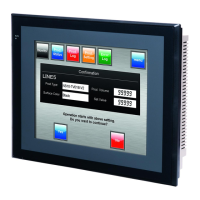1-1 Overview and Features
1-1-1 Overview
18
1-1 Overview and Features
1-1-1 Overview
The Ladder Monitor (NS-EXT01) is an application that monitors the ladder program in a
SYSMAC CS/CJ-series PLC. The Ladder Monitor enables monitoring the execution
status of the ladder program in a connected PLC from a NS-series PT without using a
Programming Device (e.g., the CX-Programmer or a Programming Console). Just by
switching to the Ladder Monitor from RUN Mode of the PT, the user can monitor the
ladder program and I/O in the PLC without changing the system configuration between
the NS-series PT and the PLC.
Just connect the NS-series PT to a CS/CJ-series PLC with a 1:N NT link, an Ethernet
connector, or a Controller Link connection to a registered host, download the project data
to the PT, place a Memory Card containing the Ladder Monitor program in the PT, and
select Ladder Monitor from the system menu of the PT. The application will start, will
monitor the ladder program and I/O of the PLC, and will display the results on the
NS-series PT screen.
Note: The Ladder Monitor only monitors the ladder program. It does not have functionality to
change or edit the program. (Force-setting/resetting bits, changing present values, and
changing timer/counter set values are enabled for the I/O memory.) In addition, I/O
comments can be displayed but symbol names cannot be displayed. Refer to Appendix A-1
Comparison between NS-series PTs and CX-Programmer (page 100) for the differences
from CX-Programmer.
Note: The following PT functions will stop when the Ladder Monitor is used.
• System memory communications with the host
• Macros
• Data log
• Alarms
• Operation log
1-1-2 Features
1. The user program can be displayed in ladder form on an NS-series PT (up to 17 rows
and 16 columns for the NS12).
2. CS/CJ-series PLCs and NSJ Controllers can be monitored. A CS/CJ-series PLC that
is connected to either serial (RS-232C) port A or B of the PT in 1:N NT Link serial
communications mode or a PLC connected to the Ethernet port or Controller Link
Board of the PT can be monitored.
3. The bit ON/OFF status (i.e., the execution conditions) and present values (words) of
the operands of special instructions can be monitored.
4. The desired program section can be specified using the Search Button.
Searching is possible for step numbers (program addresses), instructions (selected
from a list, including immediate refreshing and differentiation), and instructions with
addresses.
5. Jumping from an input bit (“contact”) to the output instruction with the same address
(i.e., to a sequence output instruction) is possible (JUMP Search). By repeating this,
it is also possible to identify the input bits causing outputs to turn ON and OFF.
6. It is possible to search for input bits that are using the address in an output
instruction.

